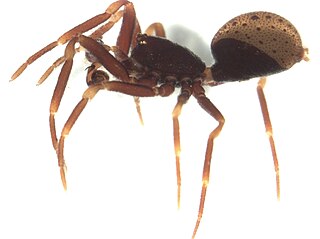
Desidae is a family of spiders, some of which are known as intertidal spiders. The family is named for the genus Desis, members of which live in a very unusual location — between the tides. The family has been reevaluated in recent years and now includes inland genera and species as well, such as Badumna and Phryganoporus. In 2017, the family Amphinectidae was merged into Desidae. The family Toxopidae has been separated off. Those intertidal spiders that are truly marine commonly live in barnacle shells, which they seal up with silk; this allows them to maintain an air bubble during high tide. They emerge at night to feed on various small arthropods that live in the intertidal zone.

Orsolobidae is a six-eyed spider family with about 180 described species in thirty genera. It was first described by J. A. L. Cooke in 1965, and was raised to family status from "Dysderidae" in 1985.

Malkaridae is a small family of araneomorph spiders first described by Valerie Todd Davies in 1980. In 2017, the family Pararchaeidae was brought into synonymy with Malkaridae.

Paradictyna is a genus of South Pacific cribellate araneomorph spiders in the family Dictynidae, and was first described by Raymond Robert Forster in 1970. As of May 2019 it contains only two species, both found in New Zealand: P. ilamia and P. rufoflava.
Gohia is a genus of South Pacific araneomorph spiders in the family Toxopidae, and was first described by R. de Dalmas in 1917.
Goyenia is a genus of South Pacific intertidal spiders that was first described by Raymond Robert Forster in 1970.
Hapona is a genus of South Pacific araneomorph spiders in the family Toxopidae, and was first described by Raymond Robert Forster in 1970. Originally placed with the intertidal spiders, it was moved to the Toxopidae in 2017.
Helsonia is a monotypic genus of South Pacific intertidal spiders containing the single species, Helsonia plata. It was first described by Raymond Robert Forster in 1970, and has only been found in New Zealand.
Mangareia is a genus of South Pacific intertidal spiders that was first described by Raymond Robert Forster in 1970. As of May 2019 it contains only two species, both found in New Zealand: M. maculata and M. motu.
Matachia is a genus of South Pacific intertidal spiders that was first described by R. de Dalmas in 1917. Originally placed with the Psechridae, it was moved to the intertidal spiders in 1970.
Notomatachia is a genus of South Pacific intertidal spiders that was first described by Raymond Robert Forster in 1970. As of May 2019 it contains only three species, all found in New Zealand: N. cantuaria, N. hirsuta, and N. wiltoni.
Otagoa is a genus of South Pacific araneomorph spiders in the family Toxopidae, and was first described by Raymond Robert Forster in 1970. As of May 2019 it contains only three species, all found in New Zealand: O. chathamensis, O. nova, and O. wiltoni.

Rapua is a monotypic genus of South Pacific intertidal spiders containing the single species, Rapua australis. It was first described by Raymond Robert Forster in 1970, and has only been found in New Zealand.
Tuakana is a genus of South Pacific intertidal spiders that was first described by Raymond Robert Forster in 1970. As of May 2019 it contains only two species, both found in New Zealand: T. mirada and T. wiltoni.
Viridictyna is a genus of South Pacific cribellate araneomorph spiders in the family Dictynidae, and was first described by Raymond Robert Forster in 1970.
Kapanga is a genus of South Pacific dwarf sheet spiders that was first described by Raymond Robert Forster in 1970.
Rinawa is a genus of South Pacific dwarf sheet spiders that was first described by Raymond Robert Forster in 1970.

Physoglenidae is a family of araneomorph spiders first described by Alexander Petrunkevitch in 1928 as a subfamily of Pholcidae. It was later moved to Synotaxidae until a study in 2016 showed that they formed a distinct clade.

Toxopidae is a small family of araneomorph spiders, first described in 1940. For many years it was sunk into Desidae as a subfamily, although doubts were expressed as to whether this was correct. A large-scale molecular phylogenetic study in 2016 led to the family being revived.







